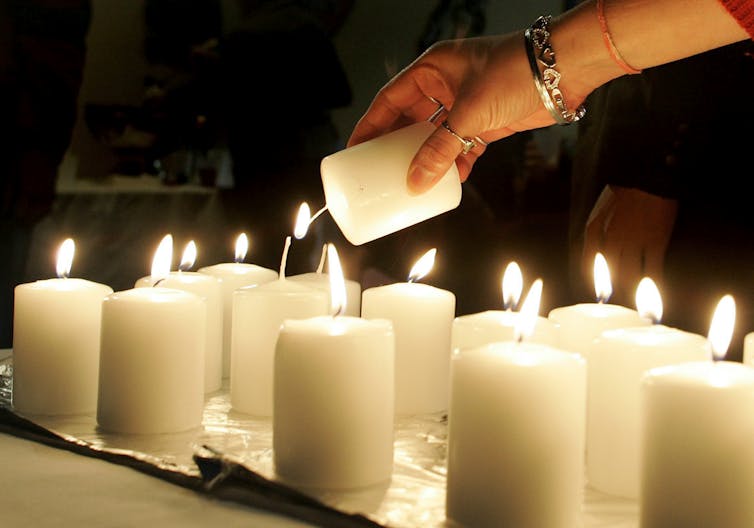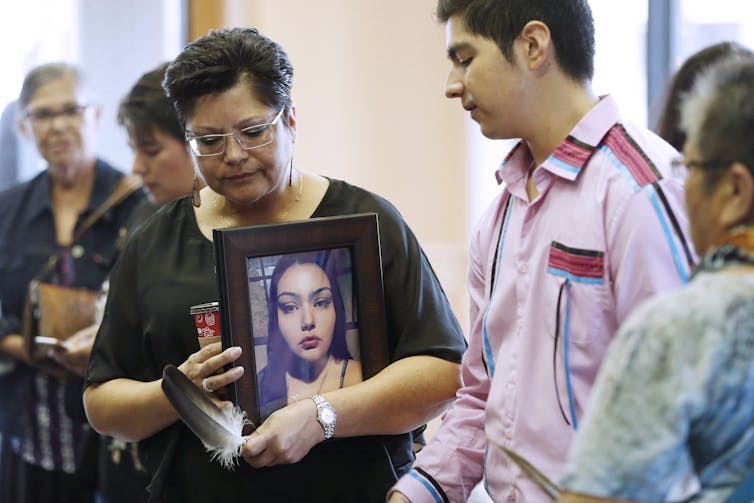A continuum of violence: Remembering the massacre at École Polytechnique
Opinion: If gendered violence is to be eradicated, we need to start from ground up and traverse the pathways of its escalation, intervening at every step
(MTL103)MONTREAL, Dec, 9, 1989–EMOTIONAL MOMENT– Three unidentified women hug each other after laying flowers in front of the Polytechnical School at the University of Montreal. Fourteen women were killed after a gunman, Marc Lepine, went on a shooting spree. The Montreal Massacre. Shaney Komulainen/CP
Share

Yasmin Jiwani, Professor of Communication Studies, Concordia University
Thirty-five years ago, in 1982, when Margaret Mitchell stood in Parliament and raised the issue of domestic violence, she was laughed down by her fellow MPs. Today, Mitchell’s cry for a recognition of gender-based violence is as pertinent as ever. The National Day of Remembrance and Action on Violence Against Women falls on Dec. 6.
Parliament officially created the day of remembrance and action, also called White Ribbon Day, in 1991 to mark the anniversary of the murders of 14 female engineering students killed on that day in 1989 at l’École Polytechnique de Montréal.
To make her case, Mitchell quoted statistics which showed one in 10 men battered their wives. Though statistics on the rates of reported violence against women in intimate relationships have declined since Mitchell’s plea, the reality is that violence against women has not abated.
The statistical decline in the reported rates of violence may have something to do with the ongoing activism of community groups, both outside and within our major institutions.
But it also has to do with the social and psychological costs of reporting gendered violence, where, to report such violence offers little recourse to justice. In fact, such steps usually lead down a path of dismissal, trivialization and humiliation.
As the Concordia Research Chair on Intersectionality, Violence and Resistance researching violence against women and engaging in activism to end it over the past two decades, it is apparent to me that much of the progress we have made thus far would not have been possible without the broad-based coalitions of community groups, academics, front-line workers and advocates within local and national governments.

The recently acclaimed Unfounded investigative series in The Globe and Mail highlights the number of sexual assault cases reported to the police but later dismissed. The series indicated one out of every five women who reported being assaulted had their cases dismissed by police as “unfounded.”
The recent heightened media attention to high profile cases of sexual harassment has raised the public’s glare and gaze on these violations of human dignity. Public attention often propels governments and leaders to take action so as to demonstrate accountability. But actually, we have yet to see the tangible outcomes. The reality is that these high-profile cases and the findings of the Globe’s investigative series just scratch the surface.
Sexual assaults are just one point in the range of violence against women and girls. Violence against women spans an entire continuum: Bullying, stalking, dating violence, sexual abuse, financial abuse, elder abuse, trafficking, rape and murder.
Activism to end such violence has a long history and it seems the solutions are within reach. Yet, we don’t seem to be moving forward. Why?
Vulnerable to violence: Gender, class, religion
Gender is a key determinant in this process. In Canada, in the context of intimate violence, women are twice as likely as men to report being choked, beaten, threatened with a knife or gun, and being sexually assaulted. Moreover, women and girls constitute almost 70 per cent of victims of family violence.
Power dynamics also adversely affect women: class, religion, age, sexuality and ability impact vulnerability to violence. For example, Indigenous women are more vulnerable to different forms of violence — both intimate sexual violence and structural violence. Women living in poverty are also more vulnerable. Young women experience the highest rates of violence.
Similarly, women who have little or no access to services, or who are socially marginalized — such as the elderly, those in rural areas, women who are racialized and stigmatized, LGBTQ2 or gender non-conforming — are more susceptible to different forms of violence.
Contextual factors undoubtedly influence which women are more at risk of violence. The harassment of Muslim women since Sept. 11, 2001, is one example. They have been targeted in hate crimes across the country for wearing the hijab and niqab.
At Dalhousie University, the student union has been providing emergency hijab kits for women students whose hijabs have been forcibly removed.
Transgendered individuals have consistently been maligned and killed because of their sexual identities.

Missing and murdered Indigenous women and girls
The ultimate form of violence is death, and while homicide rates have declined nationally, women are still dying as a result of male violence. On average, in Canada, a woman is killed every six days by her intimate partner.
Historical factors also influence the degree of vulnerability that particular women experience: the number of disappeared and murdered Indigenous women are now estimated to be around 4,000 and the rate at which they are murdered is seven times higher than non-Indigenous women.
The violence Indigenous women experience is rooted in colonialism, during which time they were sexually exploited by traders, colonial agents and miners. These relations of power still persist and influence how Indigenous women are perceived negatively and as disposable others.
It is these intersections between gender, religion, sexuality, indigeneity and other aspects of identity that put specific groups of women at increased risk of violence.

Time for action
Yet, numbers don’t tell the whole story. Clearly, histories and context matter. This is where the expertise of front-line workers, advocates, activists and academics can inform a viable strategy on how to end violence.
The federal government’s strategy to prevent and address Gender-Based Violence, launched in June, offers a promising beginning. Yet, so much of what the strategy is predicated on has been documented repeatedly in numerous consultations held over the last five decades or more.
Isn’t it time to put consultations to rest? Funding clearly needs to be provided for necessary shelters, services and much needed forms of intervention. A survey by Statistics Canada documented 8000 women and children use these facilities to escape abuse.
After all, such consultations were carried out extensively and informed the final reports of the Canadian panel on violence against women established by the federal government in 1991 as a result of the École Polytechnique massacre of young women. Since then, there have been so many other consultations charting the terrain of gender-based violence.
I am not advocating for all action and no research. But instead, I am advocating for a research agenda which is participatory and focuses on how different systems are contributing to the perpetuation of gendered violence. Services require immediate funding but so do advocates and strategic research initiatives.
If gendered violence is to be eradicated, we need to start from ground up and traverse the pathways of its escalation, intervening at every step of the way with tangible nets of safety and security, eliminating the attitudes, barriers and values that keep such violence intact. Until then, the violence will continue unabated.